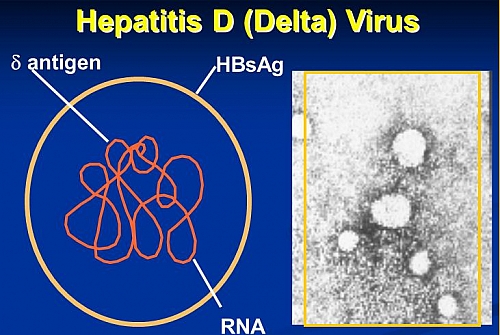Table of Contents
- What is Hepatitis D?
- Hepatitis D Virus morphology
- Epidemiology of Hepatitis D
- Hepatitis D symptoms and signs
- Hepatitis D Characteristics
- Hepatitis D Transmission
- People at risk of getting Hepatitis D infection
- Hepatitis D laboratory diagnosis
- Complications of Hepatitis D
- Hepatitis D Treatment drugs
- Hepatitis D Prevention
What is Hepatitis D?
Hepatitis D is an inflammation of the liver cells caused by a microorganism known as the Hepatitis D Virus (HDV). It can cause Hepatitis D infection; this infection does not occur on its own but coexist with Hepatitis B virus (HBV) and can only cause severe infection on those with Hepatitis B infection. When it causes infection at the same time with Hepatitis B, it is known as Co-Infection; when it causes infection following Hepatitis B infection, it is known as Super-infection. Chronic HBV carriers are at risk of having HDV.
Incubation period for superinfection with Hepatitis D takes 2 to 8 weeks for symptoms to manifest but coinfection has an incubation period the same as Hepatitis B which is about 45 to 160 days.
Hepatitis D Virus morphology
Discovered in 1977 by Mario Rizzetto of Italy and colleagues, Hepatitis D virus is a single stranded defective RNA virus that requires Hepatitis B surface antigens (HBsAg) for its transmission and it is also called the Delta agent because it has a protein known as the delta antigen; it is sensitive to formalin. Hepatitis D has an unassigned viral Family.
Epidemiology of Hepatitis D
Hepatitis D is endemic in the Middle East, northern parts of South America and Central Africa
Hepatitis D symptoms and signs
The symptoms of Hepatitis D are similar as that ofother Hepatitides such as Hepatis A, B, or Hepatitis Cinfection and include:
- Yellowish discoloration of eyes and skin (known as jaundice)
- Fever
- Abdominal pains
- Dark urine
- Vomiting
- Poor appetite
- Joint pains
- Fatigue
- Some people may have no symptoms
Hepatitis D Characteristics
- It only infects when you have Hepatitis B
- It is also known as the Delta agent
- It can cause coinfection or superinfection
Hepatitis D Transmission
How do you get infected with Hepatitis D?
People do get Hepatitis D when they become infected by Hepatitis B infection because it cannot infect you unless you have once had Hepatitis B or you are currently having Hepatitis B. It is a blood borne infection; transmission from mother to child during pregnancy is not common.
People at risk of getting Hepatitis D infection
- Having multiple sexual partners
- Those who have chronic liver disease cause by HBV
- Those who use intravenous drugs (injection drug abusers)
- People having kidney disease that are undergoing hemodialysis
- Those receiving blood transfusion or blood products such as hemophiliacs
These are the high risk group because they have a higher chance of getting infected by Hepatitis B and hence with Hepatitis D too.
Hepatitis D laboratory diagnosis
Serological test for detecting antibodies against the Hepatitis D virus helps in making a diagnosis of Hepatitis D infection. People with Hepatitis D virus RNA in their blood are infectious.
Complications of Hepatitis D
Being coinfected with Hepatitis D increases the risk of liver damage such as liver cirrhosis, liver failure and liver cancer (hepatocellular carcinoma) that are caused by Hepatitis B; this can also lead to death or need for liver transplant.
Hepatitis D Treatment drugs
Some drugs such as pegylated interferon alpha (PEG-IFN-alpha) are used for management of Hepatitis D and can clear the virus in about 15 to 25 people out of 100 infected with the virus. The treatment last for 48 weeks (about a year).
Novel treatments for Hepatitis D include:
Lonafarnib: a prenylation inhibitor that blocks the combination of the Hepatitis B surface antigen with the Hepatitis D antigen.
Myrcludex B: this blocks the receptor necessary for a specific transport protein
Hepatitis D Prevention
There is no vaccine for Hepatitis D but when you take vaccines for Hepatitis B, it provides protection from Hepatitis D because it cannot infect you without the presence of Hepatitis B. other means of prevention entails you avoid any thing that aids transmission such as:
- Avoid sharing of needles or razor blades
- Disinfect all items that have come in contact with blood
- Avoid sexual promiscuity


